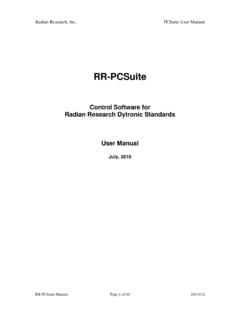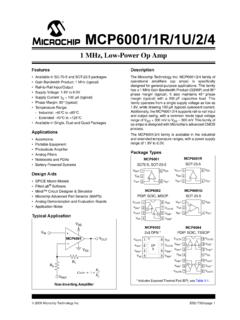Transcription of Admittance Testing CT Installation Integrity - Power
1 IntroductionInstrument transformers , more commonly known as current and Potential transformers are remotely located from the electricity me-ter and wired into the primary circuits of the service. During Installation and subsequent evaluation of the service, the accuracy and per-formance of instrument transformers are often overlooked. Traditionally CT Burden testers Radian Research, TestingVerifi esCT InstallationIntegrityAn Admittance tester confi rms the installed condition of the current transformer s internal burden and external connected burden by monitoring its been the only device available for in-ser-vice accuracy certifi cation of instrument trans-formers.
2 Unfortunately, due to the limited No Light Load burden capabilities, Testing of the instrument transformers have been neglected or performed incorrectly. The expense of removing them from the primary service and the inconve-nience of service interruptions to the customer has also prevented Testing . Today, the high cost of energy is driving utilities to review all aspects of revenue loss. These losses, which can be in the millions of dollars, are driving focus on the CT in-stallation. There is an over-whelming goal to gain effi -ciencies and reduce losses related to Power theft, bill-ing mistakes and installa-tion errors.
3 Utilities have experienced single site CT Installation mistakes that have cost the utility over $300,000 in favor of the customer. Application Note 1109 AAdmittance Testing 101 Admittance Testing checks for abnormal admit-tance by injecting an audio frequency into the secondary of an in service transformer, and de-tecting the circuit Admittance . Admittance (Y) is the inverse of impedance (Z) and is typically shown as mS (miliSiemens). The Radian 505 CT/PT Analyzer uses an audio frequency of 1575 Hz. When injected onto a 50/60Hz line, avoids interaction with harmonics that may be present, and possibly cause a false signal in the audio frequency detecting circuitry.
4 Why Test Admittance ?Relaying or metering cur-rent transformers have very low error when operated within the specifi ed current and burden ratings. There-fore, it is known that the cir-cuit Admittance of any par-ticular current transformer Installation is nearly con-stant throughout the normal operating range, unless a fault condition develops. If the Admittance mea-surement shows a deviation from normal while in service, it is likely that the current transformer will have: (1) an internal short (usually a shorted turn, where as the Z in FIGURE will change); (2) an abnormal internal or external resistance (such as a high-resistance connection - loose or corroded, where as the R in FIGURE will increase); or (3) the current transformer is op-erating under abnormal conditions (such as dc in the primary).
5 Serious faults are immediately obvious due to an abnormally high Admittance reading, normally at least times the normal reading. transformers with a wrong ratio, ex-ampled as a connection to the wrong tap, will have readings substantially different than nor-mal Research, best way to establish the "normal" reading is to record measurements during Installation and at subsequent test intervals. Admittance values depend on the transformer's XL as seen in FIGURE The XL value will encompass the transformer core design, burden rating, ratio, etc., but additions due to non-fault conditions (such as temperature, primary load, etc.)
6 Are small in comparison to the change caused by fault conditions. In-service current transformers are usually tested in groups, a high Admittance reading obtained on one current transformer in the group strongly implies that a fault condition does exist. Admittance Testing provides a quick, non-invasive way to evaluate the CT Installation Integrity , with or without load, at the customer site."Burden Only" Testing is not Suffi cient current transformers are designed to supply a known current , dictated by the turns ratio, into a known burden and maintain a stated accuracy. The principle of a current transformer burden tester is to challenge the capability of the cur-rent transformer in service to deliver a current into the existing known burden challenge is presented to the in ser-vice current transformer secondary in the form of a known ohmic resistance value that is added in series with the current transformer secondary loop.
7 The total burden of the current transformer secondary loop is made up of the watthour meter or relay current coils, the mounting device, test switch, connection resistances, and the length and size of the loop wiring. Therefore, each current transformer has a unique secondary burden when installed in a relaying or metering circuit. Assuming that the technician or engi-neer has properly sized the current transformer to withstand the secondary burden, the current transformer will provide currents according to its accuracy class rating. Should the burden tester s additional burden exceed the designed burden capability of the current transformer, the transformer will not be able to supply the same level of current to the increased burden and the net result is a drop in the transformers second-ary current .
8 A typical burden challenge is shown in FIGURE The amount of this current drop is dependent on a number of factors and is not absolutely defi nable. The operating current level of the current transformer is a major factor. current transformers operating at very low currents can support several times the burden rating because at low currents the fl ux density of the core is reduced leaving a considerable margin for ad-ditional fl ux before saturation. Therefore, per-forming burden test at low secondary current levels is not very accurate or conclusive. The most accurate and revealing burden tests are performed at the full rated secondary current .
9 At the upper end of the current range, additional burden quickly pushes the current transformer out of its operating range and causes signifi cant drops in output factor affecting the current transformer burden capability is the current transformer rat-ing factor. current transformers with high rat-ing factors can support additional burden than that given on the CT nameplate for the nominal 5 ampere rating. Therefore, the same interpre-tative consideration as with low second-ary currents must be exercised in these CT TestsCT Ratio TestA CT ratio test is performed by placing clamp-on amp meters on both the pri-mary and the secondary circuit wires.
10 Then record the measurement of current fl ow-ing in both at as near to simultaneous as possi-ble. The simultaneous readings are required for loads that are variable. The ratio is calculated by dividing the current reading of the secondary into the primary current reading. Example (350 primary amps / secondary amps = 100:1 ra-tio). The resultant is the ratio. The nameplate rating for a 5 amp current transformer would be fi ve times that or 500:5. Phase Angle TestSome test equipment provides a phase angle in-dication. The phase angle measurement can be used to verify polarity of the current transformer under test.









